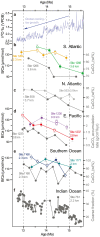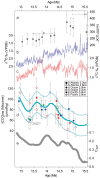Deep ocean carbonate ion increase during mid Miocene CO2 decline
- PMID: 24569646
- PMCID: PMC3935200
- DOI: 10.1038/srep04187
Deep ocean carbonate ion increase during mid Miocene CO2 decline
Abstract
Characterised by long term cooling and abrupt ice sheet expansion on Antarctica ~14 Ma ago, the mid Miocene marked the beginning of the modern ice-house world, yet there is still little consensus on its causes, in part because carbon cycle dynamics are not well constrained. In particular, changes in carbonate ion concentration ([CO3(2-)]) in the ocean, the largest carbon reservoir of the ocean-land-atmosphere system, are poorly resolved. We use benthic foraminiferal B/Ca ratios to reconstruct relative changes in [CO3(2-)] from the South Atlantic, East Pacific, and Southern Oceans. Our results suggest an increase of perhaps ~40 μmol/kg may have occurred between ~15 and 14 Ma in intermediate to deep waters in each basin. This long-term increase suggests elevated alkalinity input, perhaps from the Himalaya, rather than other shorter-term mechanisms such as ocean circulation or ecological changes, and may account for some of the proposed atmospheric CO2 decline before ~14 Ma.
Figures



References
-
- Holbourn A., Kuhnt W., Schultz M. & Erlenkeuser H. Impacts of orbital forcing and atmospheric carbon dioxide on Miocene ice-sheet expansion. Nature 438, 483–487 (2005). - PubMed
-
- Flower B. P. & Kennett J. P. The Middle Miocene climatic transition: East Antarctic ice sheet development, deep ocean circulation and global carbon cycling. Palaeogeogr. Palaeoclimatol. Palaeoecol. 108, 537–555 (1994).
-
- Holbourn A., Kuhnt W., Schultz M., Flores J.-A. & Anderson N. Orbitally-paced climate evolution during the middle Miocene “Monterey” carbon-isotope excursion. Earth Planet. Sci. Lett. 261, 534–550 (2007).
-
- Coxall H. K., Wilson P. A., Pälike H., Lear C. H. & Backman J. Rapid stepwise onset of Antarctic glaciation and deeper calcite compensation. Nature 433, 53–57 (2005). - PubMed
-
- Kennett J. P. & Barker P. F. Latest Cretaceous to Cenozoic climate and oceanographic developments in the Weddell Sea, Antarctica: an ocean-drilling perspective. Proc. Ocean Drill. Program Sci. Results 113, 937–960 (1990).
Publication types
MeSH terms
Substances
LinkOut - more resources
Full Text Sources
Other Literature Sources
Medical

